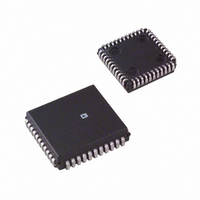AD2S83IP-REEL Analog Devices Inc, AD2S83IP-REEL Datasheet - Page 8

AD2S83IP-REEL
Manufacturer Part Number
AD2S83IP-REEL
Description
IC R/D CONV TRACKING 44PLCC T/R
Manufacturer
Analog Devices Inc
Type
R/D Converterr
Datasheet
1.AD2S83IPZ-REEL.pdf
(19 pages)
Specifications of AD2S83IP-REEL
Rohs Status
RoHS non-compliant
Input Type
Parallel
Output Type
Digital
Interface
Parallel
Current - Supply
30mA
Mounting Type
Surface Mount
Package / Case
44-PLCC
AD2S83
COMPONENT SELECTION
The following instructions describe how to select the external
components for the converter in order to achieve the required
bandwidth and tracking rate. In all cases the nearest “preferred
value” component should be used, and a 5% tolerance will not
degrade the overall performance of the converter. Care should
be taken that the resistors and capacitors will function over the
required operating temperature range. The components should
be connected as shown in Figure 1.
Free PC compatible software is available to help users select the
optimum component values for the AD2S83, and display the transfer
gain, phase and small step response.
For more detailed information and explanation, see the Circuit
Functions and Dynamic Performance section.
1. HF Filter (R1, R2, C1, C2)
2. Gain Scaling Resistor (R4) (See Phase Sensitive Demodula-
3. AC Coupling of Reference Input (R3, C3)
The function of the HF filter is to remove any dc offset and
to reduce the amount of noise present on the signal inputs to
the AD2S83, reaching the Phase Sensitive Detector and
affecting the outputs. R1 and C2 may be omitted—in which
case R2 = R3 and C1 = C3, calculated below—but their use
is particularly recommended if noise from switch mode
power supplies and brushless motor drive is present.
Values should be chosen so that
and f
This filter gives an attenuation of three times at the input to
the phase sensitive detector.
tor section.)
If R1, C2 are used:
where 100 × 10
If R1, C2 are not used:
where E
Select R3 and C3 so that there is no significant phase shift at
the reference frequency. That is,
with R3 in Ω.
REF
= 40 × 10
= 10 × 10
= 2.5 × 10
= Scaling of the DC ERROR in volts/LSB
DC
= Reference Frequency
= 160 × 10
–9
–3
–3
–3
R4 =
= current/LSB
15 kΩ ≤ R1= R2 ≤ 56 kΩ
C1= C2 =
for 12 bits
for 14 bits
for 16 bits
100 × 10
R3 = 100 kΩ
C 3 >
R4 =
E
–3
DC
for 10 bits resolution
100 × 10
R3 × f
2 π R1 f
−9
E
1
DC
×
1
REF
1
3
REF
–9
Ω
Ω
F
(Hz)
4. Maximum Tracking Rate (R6)
where n = bits per revolution
5. Closed-Loop Bandwidth Selection (C4, C5, R5)
6. VCO Phase Compensation
7. VCO Optimization
The VCO input resistor R6 sets the maximum tracking rate
of the converter and hence the velocity scaling as at the max
tracking rate, the velocity output will be 8 V.
Decide on your maximum tracking rate, “T,” in revolutions
per second. When setting the value for R6, it should be
remembered that the linearity of the velocity output is
specified across 0 kHz–500 kHz and 500 kHz–1000 kHz.
The following conversion can be used to determine the
corresponding rps:
Note that “T” must not exceed the maximum tracking rate
or 1/16 of the reference frequency.
a. Choose the closed-loop bandwidth (f
Resolution
Typical values may be 100 Hz for a 400 Hz reference fre-
quency and 500 Hz to 1000 Hz for a 5 kHz reference
frequency.
b.
c.
d.
The following values of C6 and R7 should be connected as
close as possible to the VCO output, Pin 41.
To optimize the performance of the VCO a capacitor, C7,
should be placed across the VCO input and output, Pins 40
and 41.
ensuring that the ratio of reference frequency to band-
width does not exceed the following guidelines:
= 1,024 for 10 bits resolution
= 4,096 for 12 bits
= 16,384 for 14 bits
= 65,536 for 16 bits
10
12
14
16
Select C4 so that
with R6 in Ω and f
C5 is given by
R5 is given by
C6 = 390 pF, R7 = 3. 3 kΩ
Ratio of Reference Frequency/Bandwidth
rps =
R5 =
R6 =
C4 =
C7 = 150 pF
VCO Rate (Hz)
2 × π × f
BW
6.81 × 10
C5 = 5 × C4
, in Hz selected above.
T × n
R6 × f
2
N
4
21
BW
10
BW
Ω
× C5
2.5 : 1
4
6
7.5 : 1
2
BW
F
) required
: 1
: 1
Ω













